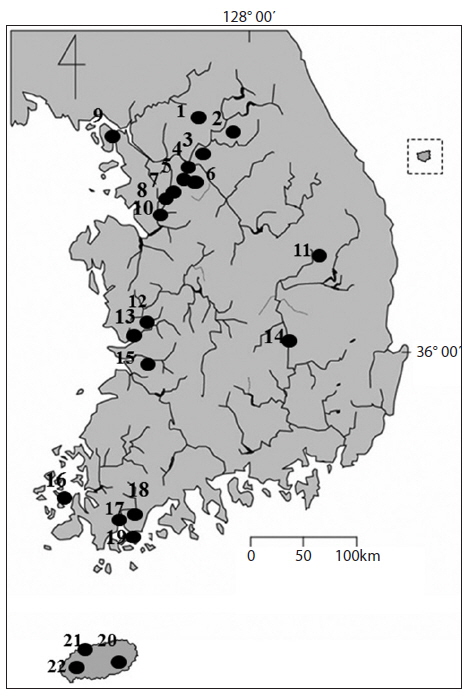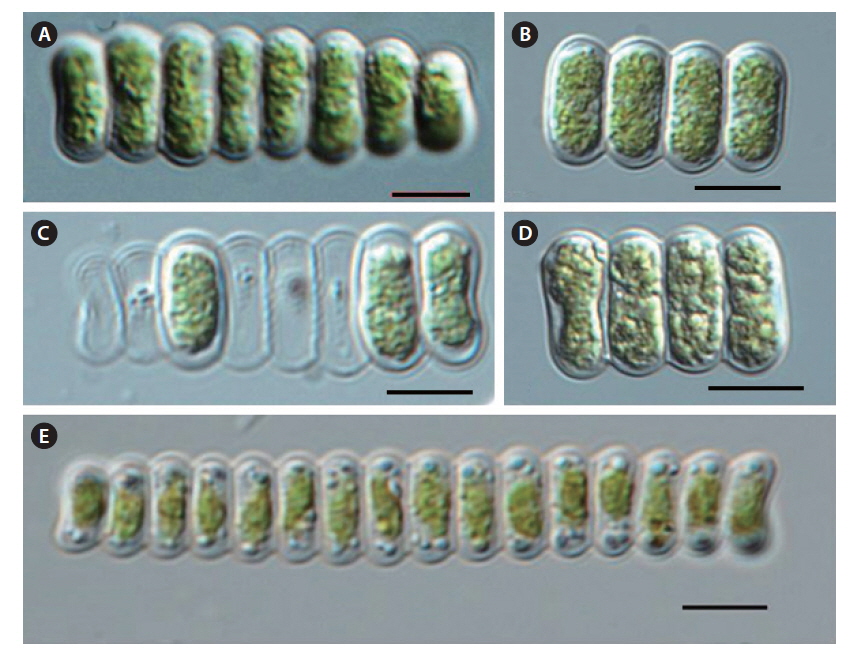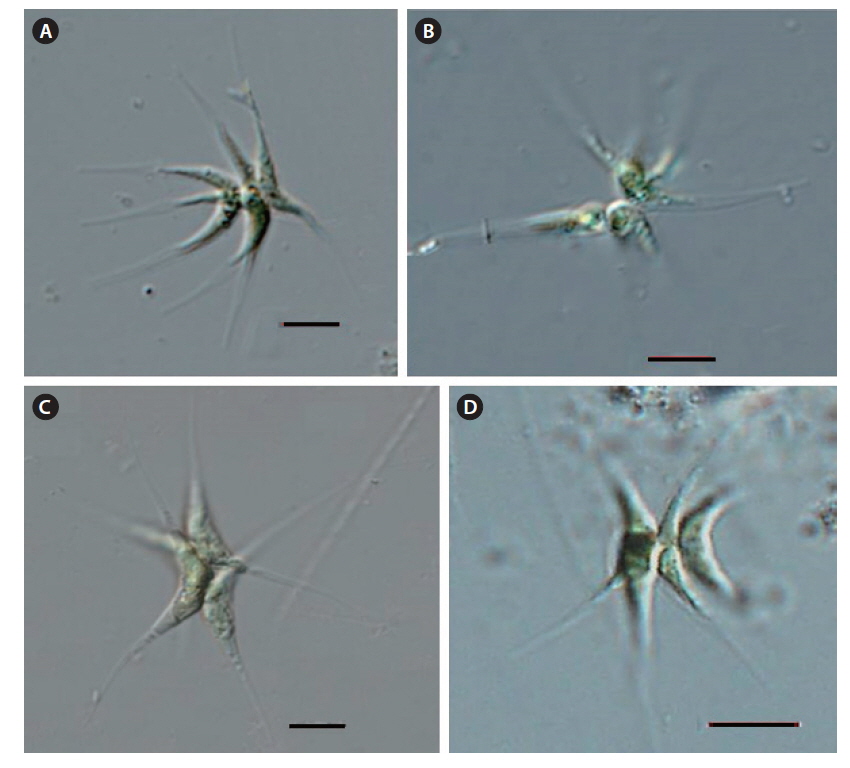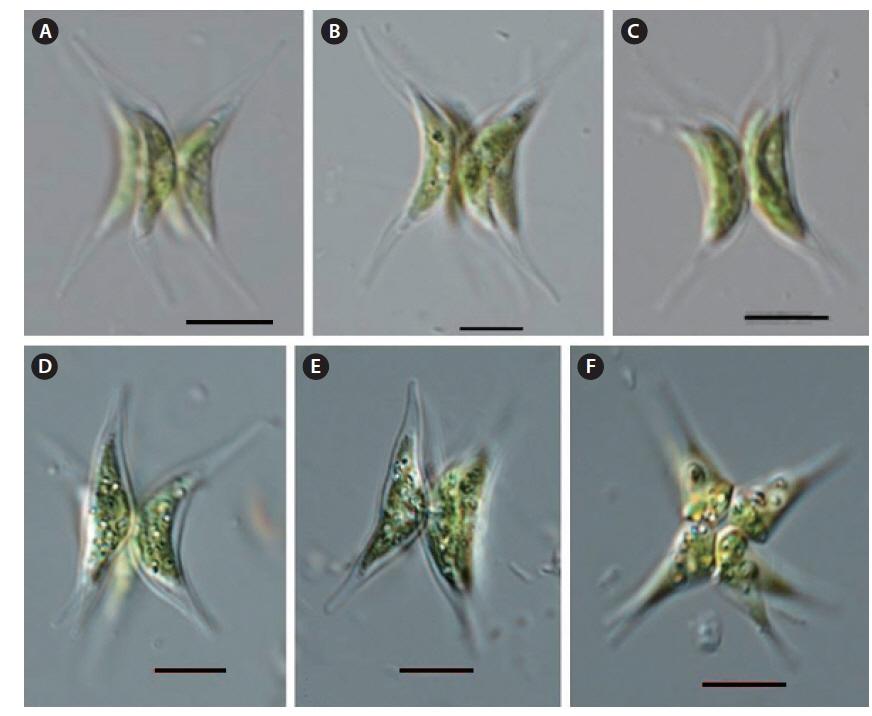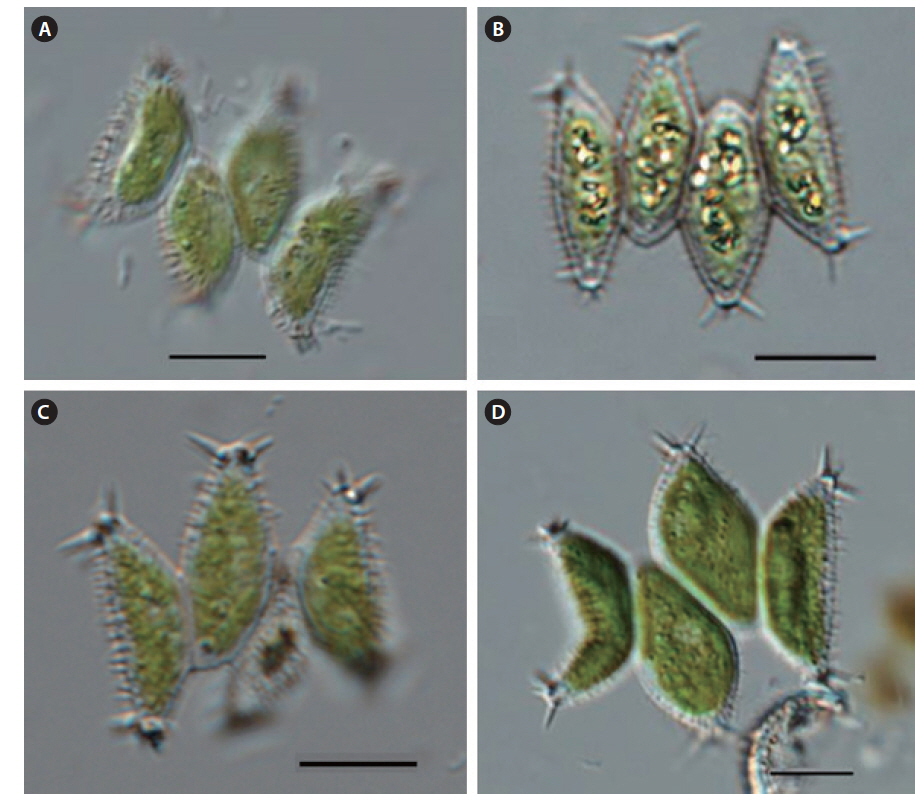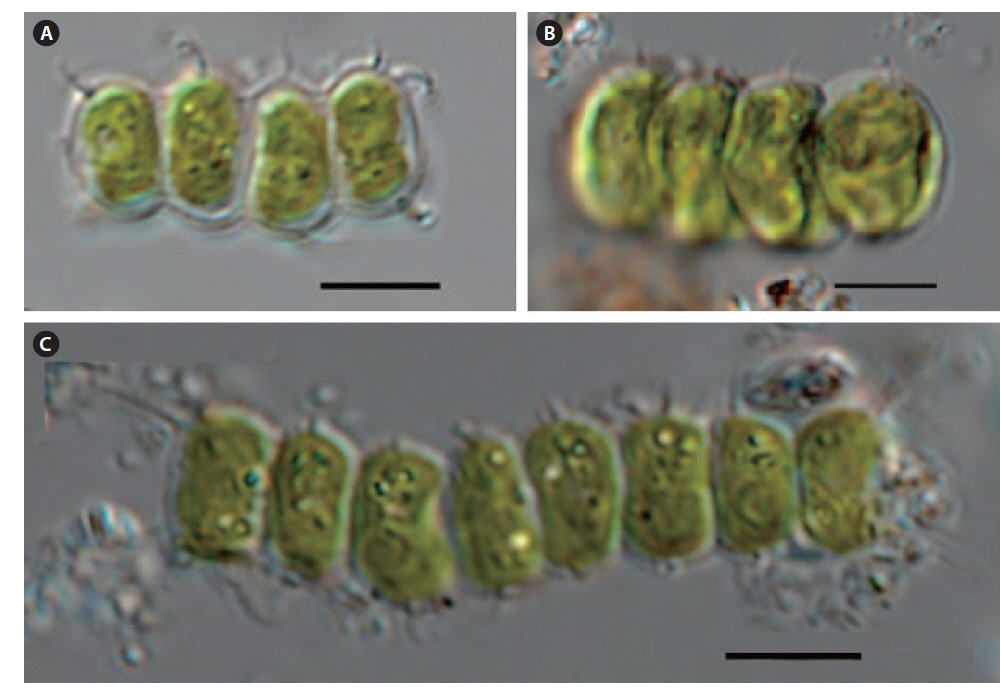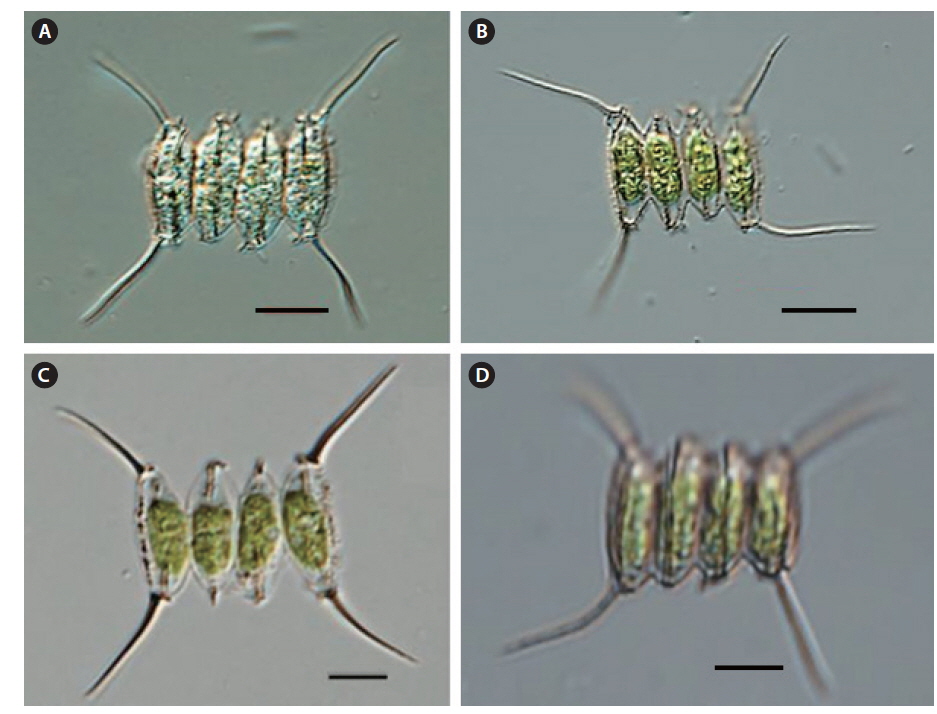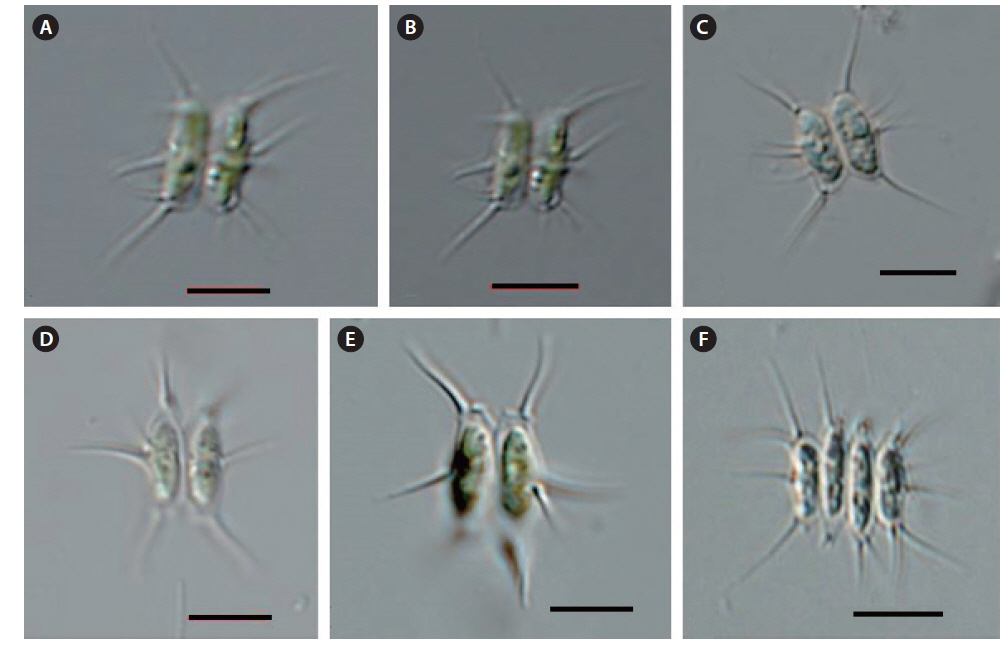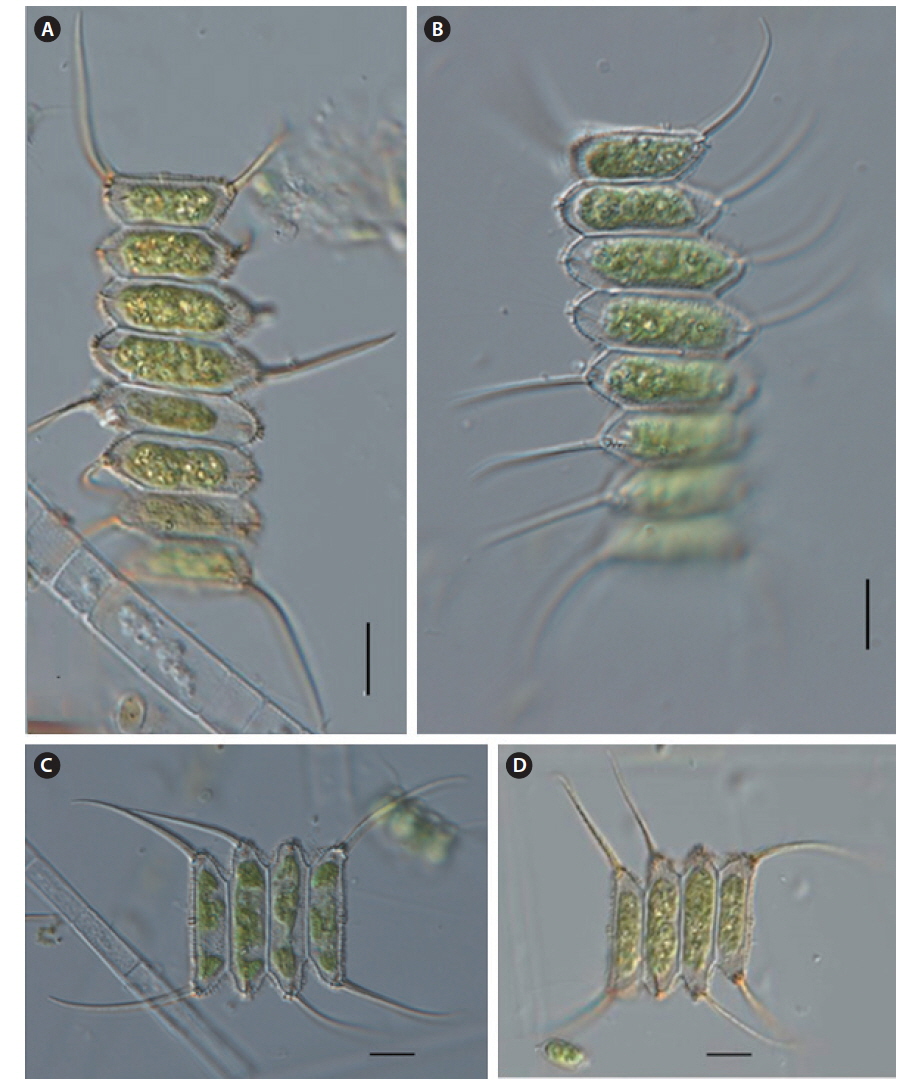



The family Scenedesmaceae is coccal green algae, which is arranged into microscopic, flat, spherical, and circular coenobia. This family is classified into 6 subfamilies and 28 genera (Komárek and Fott 1983). The subfamily Scenedesmoideae is composed of 8 genera. The genus
The morphological variabilities in
The genus
[Table 1.] Information of sampling sites of the genus Scenedesmus in South Korea
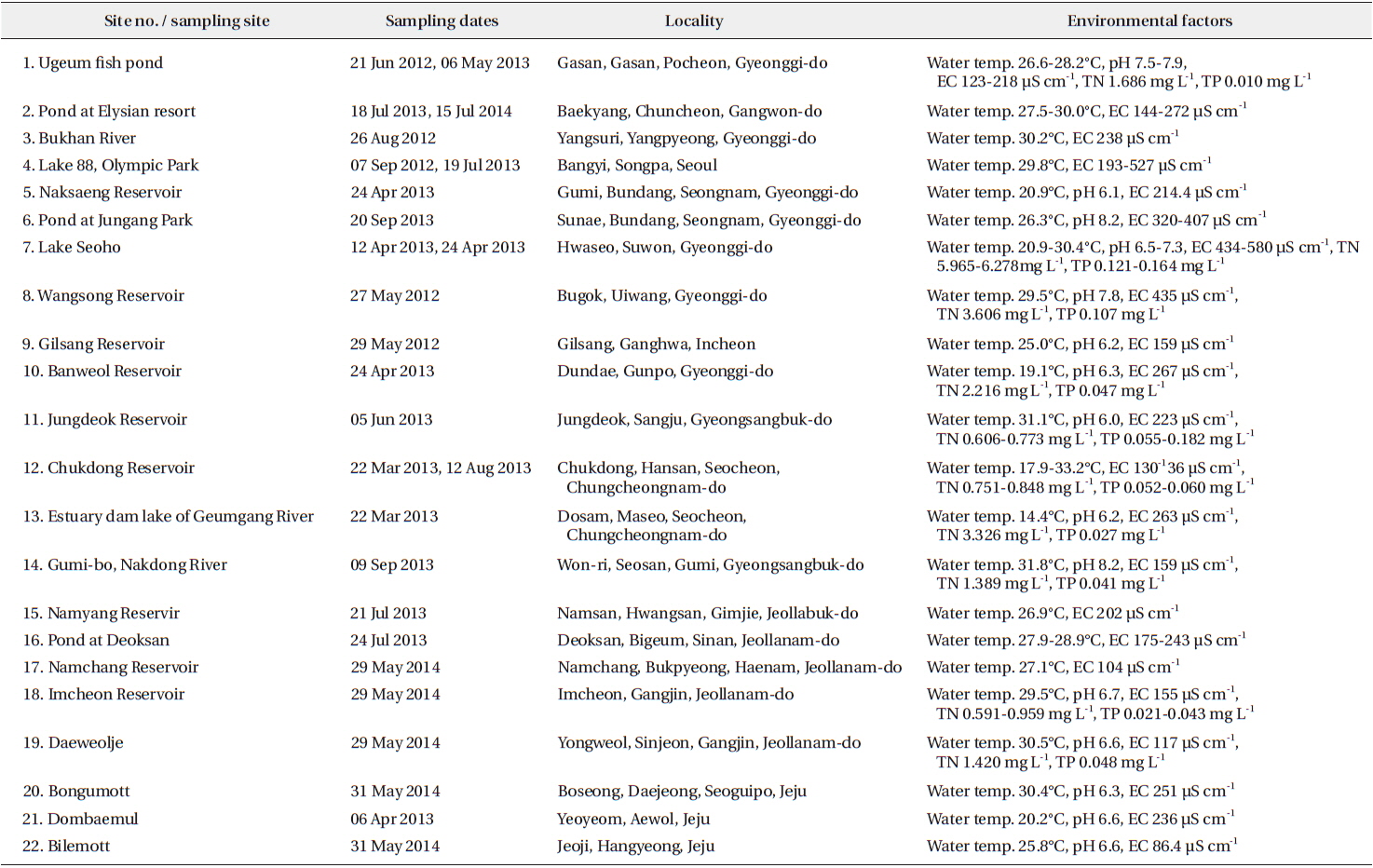
Information of sampling sites of the genus Scenedesmus in South Korea
The samples of the genus
At each site, physical and chemical factors of water were recorded during the sampling period (Table 1). Water temp. (Water temperature, °C) and EC (electric conductivity) was measured in situ using a portable thermometer and EC meter (Orion 5-star; Thermo Fisher Scientific, Waltham, MA, USA), and pH was measured in situ using a pH meter (Ultrabasic-5; Denver Instrument, Bohemia, NY, USA) respectively. The data for total nitrogen (TN) and total phosphate (TP) concentrations at each sampling site was referred from the water information system of the Ministry of Environment (NIER 2014).
The genus
Scenedesmus linearis Komarek (
References: Komárek and Fott 1983, p 832, taf. 226, fig. 6; Hegewald and Silva 1988. p 298, fig. 487.
Description: Coenobia are 4-8-16 cells, linearly arranged cells, with 3-quarters of the cell length conjoined. cells are cylindrical with broadly rounded cell poles and slightly thick cell walls. The outsides of the marginal cells are slightly concave. Cell walls are smooth without teeth, spines, or granulates. Cells have a single chloroplast and a pyrenoid. Cells are 14-20 μm long and 5-8 μm wide.
Occurrence sites: 3, 14, 18, 20, 21, 22 (Table 1 and Fig. 1)
>
Subgenus Acutodesmus Hegewald
Scenedesmus acuminatus var. elongatus G.M. Smith (
References: Uherkovich 1966, p 43, taf. III, Abb. 80; Komárek and Fott 1983, p 844, taf. 229, fig. 2; Hegewald and Silva 1988, p 52, fig. 65.
Description: Coenobia are composed of 4-8 cells, commonly 4 cells, always forming a curved plate, with irregular twists. Cells are longer than
Occurrence site: 4 (Table 1 and Fig. 1)
Remarks: Komárek and Fott (1983) and Hegewald and Silva (1988) included this taxon into
Scenedesmus acuminatus var. tetradesmoides G.M. Smith (
References: Komárek and Fott 1983, p 842, taf. 228, fig. 5; Hegewald and Silva 1988, p 55, fig. 70.
Description: Coenobia are composed of 4-8 cells, commonly 4 cells, always forming a curved plate. Cells are arcuate or long crescent shaped, and adjoined side by side along a parallel axis, and radially arranged in apical view. Cells narrow and become fusiform, tapered, or pointed at the poles, and the outside is concave. The cell wall is smooth, without teeth, spines, or granulates. Cells have a single chloroplast, with a pyrenoid. Cells are 25-30 μm long and 5-8 μm wide.
Occurrence sites: 4, 14 (Table 1 and Fig. 1).
Remarks: Korshikov (1953) included this taxon into the basionym of
Scenedesmus denticulatus var. disciformis Hortobagyi (
References: Hegewald and Silva 1988, p 200, fig. 315; John and Tsarenko 2002, p 392, pl. 95, fig. I.
Description: Coenobia are composed of 4-8 cells, mostly arranged linearly. or with alternating cells in 1 or 2 rows, tightly joined without any space between the cells. Cells are broadly ovoid with 2-3 short teeth, sometimes outwardly directed and confined to the outer pole at inner cells and to both poles at the marginal cells, with or without fine granulates on the cell wall. Cells have a single chloroplast and a pyrenoid. Cells are 10-15 μm long and 7-10 μm wide.
Occurrence sites: 4, 9, 12, 16, 19 (Table 1 and Fig. 1).
Remarks: Komárek and Fott (1983) included the species having characteristics of
Scenedesmus polydenticulatus Hortobagyi (
References: Komárek and Fott 1983, p 868, taf. 234, fig. 10; Hegewald and Silva 1988, p 398, fig. 643; Yamagishi and Akiyama 1995, p 15, pl. 73, figs. 1-6.
Description: Coenobia are composed of 2-4-8 cells, mostly arranged linearly or in 1 or 2 rows of alternating cells that are rarely solitary, and tightly joined with or without a space between cells. Cells are broadly ovoid with 1-3-4 outwardly directed short teeth, and are confined to the outer pole at inner cells and to both poles at the marginal cells, with fine spines on the cell wall. Cells have a single chloroplast, with a pyrenoid. Cells are 15-25 μm long and 10-15 μm wide.
Occurrence sites: 7, 2, 19, 21 (Table 1 and Fig. 1).
Remarks: Komárek and Fott (1983) included
Scenedesmus lefevrei Deflandre (
References: Komárek and Fott 1983, p 874, taf. 236, fig. 4; Hegewald and Silva 1988, p 295, fig. 481.
Description: Coenobia are composed of 2-(4)-8 cells, linearly arranged in 1 row, with contact up to three-quarters of the cell length. Cells vary in shape from ellipsoidal to cylindrical, and are sometimes slightly asymmetrical, rounded, or tapered at the poles. The cells have short spines at the poles of the inner cells, while the marginal cells have slightly curved spines at the pole of the outer cells with a single longitudinal row of warty teeth or riblike structure on the side of each cell. Cells have a single chloroplast, with a pyrenoid. Cells are 15-25 μm long and 7-12 μm wide.
Occurrence sites: 1, 7 (Table 1 and Fig. 1).
Remarks: Deducenko-Scegoleva (1949) included
Kiriakov (1977) reported
Scenedesmus pannonicus Hortobagyi (
References: Komárek and Fott 1983, p 882, taf. 238, fig. 6; Hegewald and Silva 1988, p 369, fig. 598; John and Tsarenko 2002, p 397, pl. 95, fig. O.
Description: Coenobia are composed of 4-8 cells, rarely 2 cells, arranged linearly or in slightly alternating cells. Cells are ellipsoid, cylindrical, or ovoid, with sides joined in linear series. The marginal cells have a short stout spine at the poles, while the inner cells have a stout spine at one pole or both poles. Cell walls are smooth. Cells have a single chloroplast, with a pyrenoid. Cells are 10-25 μm long and 6-12 μm wide.
Occurrence sites: 1, 4, 5 (Table 1 and Fig. 1).
Remarks: Komárek and Fott (1983) included
Scenedesmus helveticus f. bicaudatus Korsikov (
References: Hegewald and Silva 1988, p 260, fig. 418.
Description: Coenobia are composed of 2-4-8 cells, mostly arranged in a linear series or a slightly alternating manner. Cells are spindle, or elliptical shaped, and are tapered to conically rounded poles. The inner cells are with or without small teeth, and the marginal cells have elongated ends, with a straight or slightly curved long spine at one pole. The outer wall of marginal cells is straight or slightly convex, with wing-like structures on the side of the marginal cell. The cell wall is smooth, with continuous or interrupted longitudinal ribs. Cells have a single chloroplast, with a pyrenoid. Cells are 15-25 μm long and 5-8 μm wide.
Occurrence sites: 11, 15, 17 (Table 1 and Fig. 1).
Scenedesmus carinatus (Lemmermann) Chodat (
References: Komárek and Fott 1983, p 913, taf. 246, fig. 3; Hegewald and Silva 1988, p 141, fig. 569.
Description: Coenobia are composed of (2)-4-8 cells, arranged in a linear series or slightly alternating row along the sides. Cells are long-fusiform, ellipsoidal, or naviculoid, with a conical or beaked pole. Cells have forked teeth spines on the poles and distinct longitudinal ribs. The marginal cells have long curved spines at the poles, and the outer side wall of marginal cells are straight or slightly convex. Cells have a single chloroplast, with a pyrenoid. Cells are 20-30 μm long and 4-8 μm wide.
Occurrence sites: 2, 4, 6, 7, 9, 17 (Table 1 and Fig. 1).
Remarks: Lemmermann (1899) reported the new species
Scenedesmus tenuispina Chodat (
References: Komárek and Fott 1983, p 916, taf. 247, fig. 1; Hegewald and Silva 1988, p 526, fig. 852.
Description: Coenobia are composed of 2-4(-8) cells, arranged in a linear series or slightly alternating row along the sides. Cells are long-ovoid and ellipsoidal with pointed poles. One to two spines are on the poles of the inner cells. The marginal cells have 1-3 spines of equal cell length at the poles. The outside wall of marginal cells is straight or slightly convex, with 2-5 spines on the opposite side. Cells have a single chloroplast, with a pyrenoid. Cells are 10-15 μm long and 3-7 μm wide.
Occurrence sites: 1, 4, 6, 8, 12, 13 (Table 1 and Fig. 1).
Remarks: Uherkovich (1966) reported new species
Scenedesmus gutwinskii var. heterospina Bodrogkozy (
References: Uherkovich 1966, p 112, pl. XIX, fig. 783; Komárek and Fott 1983, p 918, taf. 247, fig. 4; Hegewald and Silva 1988, p 258, fig. 414.
Description: Coenobia are composed of 2-4-8 cells, arranged in a linear series or slightly alternating row along the sides. Cells are long, ovoid and ellipsoidal, with conical or rounded poles. One to two teeth spines are found on the poles of the inner cells. The marginal cells have slightly curved or straight spines at one pole and short spines on other pole, with 3-8 straight or slightly convex, short spines on the outermost side. Cells have a single chloroplast, with a pyrenoid. Cells are 8-15 μm long and 3-7 μm wide.
Occurrence sites: 1, 6, 7, 8 (Table 1 and Fig. 1).
Scenedesmus oahuensis var. clathratus f. longiclathratus G. Tell (
(Synonym:
References: Komárek and Fott 1983, p 936, taf. 251, fig. 5; Hegewald and Silva 1988, p 329, fig. 539.
Description: Coenobia are composed of 4-8 cells, arranged in a linear series. Cells are long cylindrical, or ellipsoidal-cylindrical, with conical or rounded poles. The inner cells may have long spines with continuous or interrupted longitudinal ribs at the poles. The marginal cells have a straight or slightly curved long spine at the poles, and the outer side wall of marginal cells are straight or slightly convex. There are distributed granulates on the side and wall of inner and marginal cells. Cells have a single chloroplast, with a pyrenoid. Cells are 25-35 μm long and 8-12 μm wide.
Occurrence sites: 1, 4, 6, 7, 8, 13, 18 (Table 1 and Fig. 1).
Remarks: Lemmermann (1905) reported new variety
Scenedesmus oahuensis var. clathratus Manguin (
References: Komárek and Fott 1983, p 940, taf. 252, figs. 6-7; Hegewald and Silva 1988, p 329, fig. 539.
Description: Coenobia are composed of 4-8 cells, arranged in a linear series with intercellular perforation between cells along the polar region. Cells are long cylindrical or ellipsoidal-cylindrical, spool-shaped with rounded poles. The marginal cells have a straight or slightly curved long spine at the poles, while the outsides of marginal cells are straight or slightly convex. There are distributed granulates on the side and inner wall of marginal cells. Cells have a single chloroplast with a pyrenoid. Cells are 25-35 μm long and 8-12 μm wide.
Occurrence sites: 1, 4, 6, 7, 8 (Table 1 and Fig. 1).
Remarks: Manguin (1936) reported this taxon on the basis of the figure and description of
